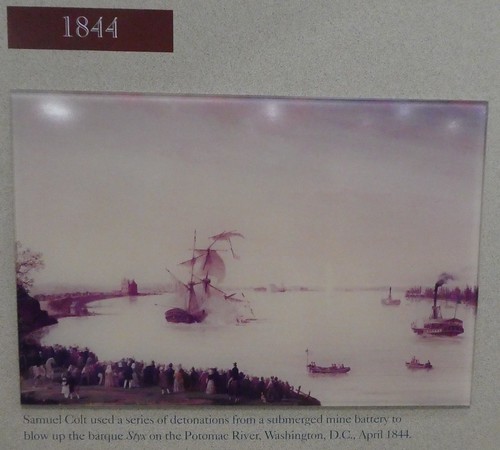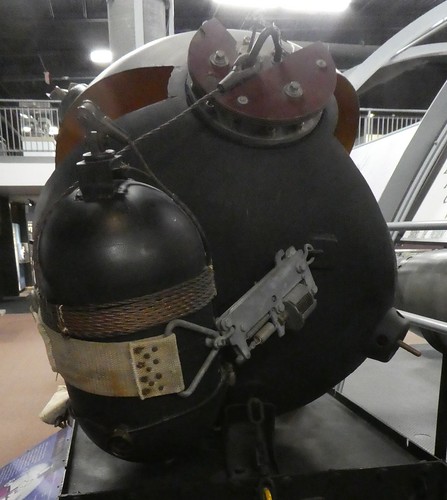The Naval Undersea Museum in Keyport, Washington includes a number of exhibits on the use of mines in undersea warfare.
According to the Museum:
“Historically, undersea warfare has involved seeking better ways to deliver large, ship-destroying weapons without being seen.”
There are two basic kinds of undersea weapons: mines, which are stationary, and torpedoes which are self-propelled.

The United States first used mines during the Revolutionary War in an attempt to force British ships to give up their blockade of American ports. Watertight wooden kegs filled with gunpowder were set afloat in the Delaware River near Philadelphia. When the keg came in contact with a sip, a spring-loaded level would trip a flintlock firing mechanism to detonate the gunpowder.
 A floating wooden keg mine is shown above.
A floating wooden keg mine is shown above.
The firing mechanism is the floating keg was a flintlock firing mechanism from the flintlock musket.
 A flintlock firing mechanism is shown above.
A flintlock firing mechanism is shown above.

Robert Fulton’s moored mine was a floating case filled with explosives. It was anchored to the bottom with a cable and used a spring released flintlock firing mechanism. During the nineteenth century, advancements in the use of electricity led to the use of electrically generated sparks to detonate explosives thus eliminating the use of the less than reliable flintlock mechanism.

Civil War

During the Civil War (1861-1865), use of undersea weapons—mines—was widespread due to developments in explosives, electricity, and metal-working.
 Shown above is a frame torpedo mine. This is a modified 10” Parrot gun shell which weighs 412 pounds. A point-detonating fuze would go in the hole.
Shown above is a frame torpedo mine. This is a modified 10” Parrot gun shell which weighs 412 pounds. A point-detonating fuze would go in the hole.
According to the Museum:
“Frame torpedoes were large artillery shells attached to wooden frames and set below the surface in shallow water, where an unsuspecting ship might blunder into and detonate them.”


World War I
During World War I, all sides used mines to destroy enemy shipping.

MK 6 Mine
This is a moored contact mine which was dropped from rails off the stern of a surface vessel. The mine weighs 1,400 pounds and carries 300 pounds of TNT.



MK 25 Mine
During World War II, aircraft became more important in laying minefields in enemy territory. The B-29 was an ideal aircraft for this task.



Destructor Mini
These were the first mines used on both land and sea. When dropped in shallow waterways, they went to the bottom where they lay ready to be set off by a passing vessel. More than 330,000 destructors were dropped during the Vietnam War.


CAPTOR Mine MK 60
According to the Museum:
“CAPTOR combines elements of a mine and a torpedo in a single weapon. It is an independent, self-contained, unmanned attack system. CAPTOR detects and verifies submarine presence. When required, it deploys a modern Mk 46 torpedo to attack and destroy the unwanted aggressor submarine traffic in the are. This innovative antisubmarine warfare system requires no further command, control, or communication after deployment.”

Influence Sensing Devices
According to the Museum:
“A pressure, magnetic, or acoustic sensing device detects a change in a mine’s surroundings. If the change exceeds a pre-set level, the sensing device responds and starts a sequence that explodes the mine.
Influence mines are usually laid on the bottom and are most effective in shallow water. If they are planted too deep, the influence sensors might not detect the target, or the detonation might be too far away to damage the target.”



More military museum exhibits
Naval Undersea Museum: Working Underwater (photo diary)
Naval Undersea Museum: Diversity and change in U.S. Navy submarines (museum tour)
Naval Destroyer Museum: On the deck of the Turner Joy (photo diary)
Lewis Army Museum: Half-Tracks (photo diary)
Lewis Army Museum: World War I (photo diary)
Veterans Memorial Museum: Military Weapons (Photo Diary)
Veterans Memorial Museum: The Vietnam War (Photo Diary)
Ohio History Center: World War I posters (photo diary)


